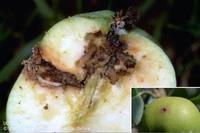Monthly Tip
Codling Moth
Tip description

Codling moth larvae bore into the center of fruit to feed. Note the excrement, including the frass pushed out of the entry hole, Jack Kelly Clark, UC.
Trees should be monitored every week for signs of infestation. Infested fruit should be removed and discarded to break the codling moth life cycle. Sanitation is an important non-chemical step in controlling this pest. Make sure to pick up fallen fruit promptly, and pick apples with holes that are still on the tree. This will keep future populations down. Pheromone traps can be hung in isolated trees. But if you have just one apple tree don't bother. You will just attract codling moths to your tree. Fruit can be bagged for protection, but this method is very labor-intensive. Heavy infestations may require the use of pesticides, but proper timing of sprays is critical. Read the UC Codling Moth Pest Note for more information.
Months applicable
Category
|






